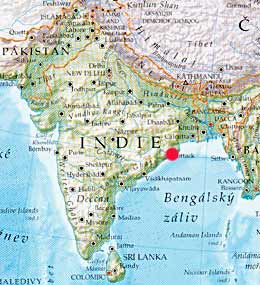 |
The city of Puri — also called Puri-on-the-Sea, Jagannatha
Puri, Nilacala,
and Sri Ksetra — is considered equal to Vrindavana and Navadvipa
(the
birthplace of Lord Krishna and Caitanya respectively) as a dhama,
or sacred Vaisnava holy place. For thousands of years great sages
and other exalted persons have traveled to Puri on pilgrimage.
Lord Caitanya Mahaprabhu chose to reside here for the last eighteen
years of His life. Jagannatha Puri is situated on the bank of
Bay of Bengal in East-Indian state Orissa.
|
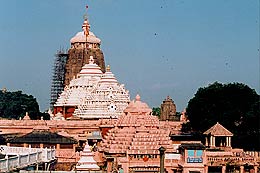 |
Jagannatha's Temple was built in ancient times by King
Indradyumna and the whole story was marvelously depicted in Tamala
Krishna's drama Jagannatha Priya-natakam (We recommend you to
get this play and relish it to heart's content).
|
 |
The present temple of Lord Jagannatha was constructed by King
Anangabheema. Historians say this temple must have been originally
constructed at least two thousand years ago.
|
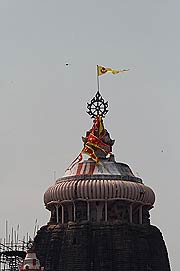 |
The main tower is 65 m high. On the top there is Neela-chakra
("the blue disc") made from alloy of eight metals (astha-dhatu)
It is 3,5 m high and each day bears different flag.
|
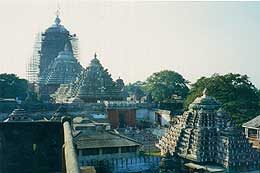 |
The lamp is lighted there on each Ekadasi.
|
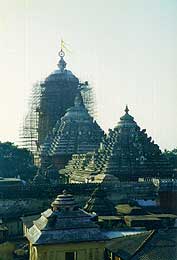 |
In Caitanya-caritamrita it is stated that if one is not for some
reason qualified to enter the temple (because of not being born-Hindu
or feels unclean), he may look at the chakra and bow down from
distance, which is as good as visiting of the temple. Lord Caitanya
was regularly visiting the temple.
|
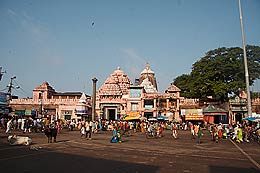 |
In front of the main gate of Jagannath Temple there is Aruna-stamba.
Carrying on the top of the stamba is the figure of Aruna the charioteer
of Sun God.
|
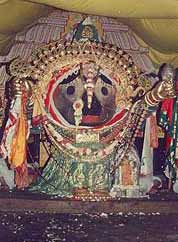 |
Lord Jagannatha
"Jagat" means "universe" and "natha"
is "master". Thus Jagannatha is "Master of the universe"
and priests are decorating Him in different ways on different occasions
- in the mood of many incarnations of the Supreme Lord as Nrsimha
or Varaha, but Gaudiya-vaisnavas prefer to see Him as Lord Caitanya
did - as Lord Krishna. Wooden Deity is so heavy that few men have
to hold each of His hand, some must push from behind and some pull
from the front. |
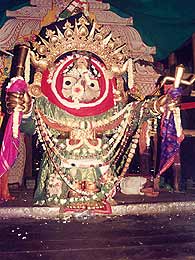 |
Baladeva (Balabhadra)
is on the left side. He is actually Balarama, older brother of Krishna,
His first expansion. |
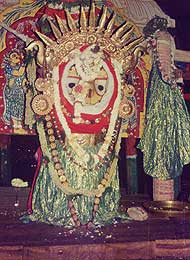 |
Lady Subhadra (in
the middle) is Krishna's sister, Divine energy. |
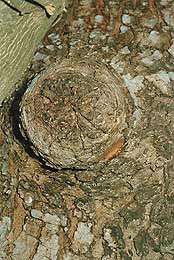 |
Since the Deities are made from wood, each 12 years Nava-kalevara-yatra
(or ritual of transformation) is hold. After elaborate preliminary
preparations, the right trees are found, Deities carved, transformation
made and old Deities buried in the ground. Last rites were done
in 1996. Though as much as half million people attend the festival,
most of the procedures are conducted in secret and no other than
few appointed priests and servants can be present.
First of all the special trees with the symbolic marks of chakra,
...
|
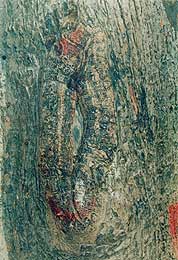 |
...conshell, mace and lotus have to be found. The search party
consists of exact numbers of man belonging to specific families
and casts. After several stops they will reach village Kakatpur
80 km from Puri. The oldest member of Dayitapati family has to
sleep in the temple of Goddess Vimala or Mangala, meaning "Auspicious
One". He must have a dream during this stay in which goddess
tells him the exact location where the trees can be found. The
tree for each of the four Deities will be in a different place
(the fourth Deity is Sudarsan). When the search party locates
the places, they may find many trees, but the sacred symbols will
be found on only one of them.
|
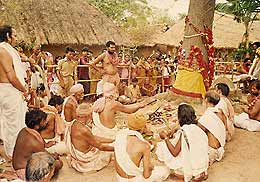 |
The Siva's temple and pond has to be nearby. Very rare types
of trees must be growing beside: The Varuna Tree, which can protect
you from snakes. It is said that this tree has the power to destroy
all anger and pride. People today often carry a piece of Varuna
bark with them if they must meet a bothersome person. The Sahada
Tree, which gives the power to forget oneself. The Vilua Tree,
which has the power to cure any disease, even heart disease, cancer
and leprosy...
|
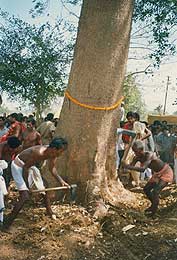 |
...The cure is obtained by chewing its leaves. All three trees
are very rare, whereas the Neem tree is very common. When the
trees are found, they must construct a small hut nearby in which
they will now reside. A great fire sacrifice is performed there
to invite all demigods to give their blessings and cutting of
the tree can start. First only the golden axe can touch the tree,
then silver and after that iron axe can finish the work. 108 names
of the Lord are chanted continuously. Neem wood will not decay
for more than thirty years and it is one of the longest-lasting
types of wood in India. Since "Neem" is called "daru"
Jagannatha Deity is also called "daru-brahman".
|
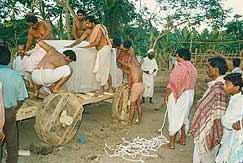 |
Only members of the Dayitapati
family have the right of carrying the huge log back to Puri and
the descendant of the original carver can carve the Deity. Only
few precisely designated servants can participate in the rites
of transformation. Old Deities are placed in front of the new
ones and three oldest members of Dayitapati family transfer "Daru-brahman"
to the new Deities...
|
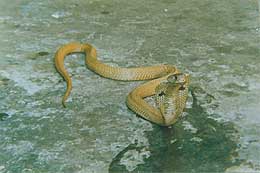 |
...Not even the head priest can be there during this time. Nava-kalevara-yatra
is actually this transformation ceremony during which all present
have very intense experiences as they blindfolded transfer "life
force" to the new Deities. Old Deities are buried in a place
known as Koili Vaikuntha. Koili means "burial ground"
and Vaikuntha means "Heaven".
Cobra representing Ananta Sesa
|
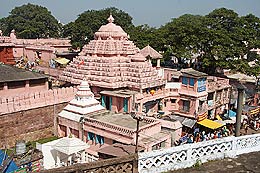 |
The temple has four gates: Simha-dwara (Lion or main Gate),
Ashva-dwara (Horse Gate), Vyaghra-dwara (Tiger Gate) and Hasti-dwara
(Elephant Gate).
|
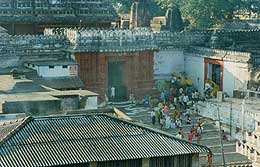 |
There is also small sanctum of Satya-narayana, Ramacandra, Nrsimhadeva
in the temple area and smaller Deity of Jagannatha called Patita-pavana
("Savior of the fallen") that can be seen by everybody
directly from the street.
|
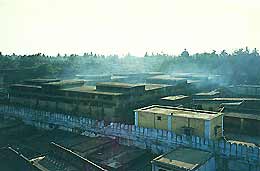 |
None of the temple kitchens in the world is as grand as
Lord Jagannatha's kitchens in Puri. Awesome and gigantic, the
Jagannatha Temple kitchens reflect centuries of tradition. Without
electricity or machines, skilled chefs work under oil lamps over
open wood fires. Every day they prepare more than a hundred different
dishes and offer them to the central Deities. Further, given only
one day's notice the chefs can prepare a full meal for up to 10 000
guests.
|
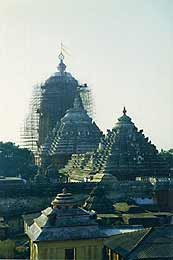 |
During Snana-yatra (bathing) festival Lord Jagannatha
is supposed to get sick and He is brought for few days to His
private rooms. There, the Anavasara (rejuvenating) ceremony
takes place. Only Dayitas, servants from the lower caste, take
care about the Lord and because He is supposed to have fever,
fruit juices are served for drink.
|
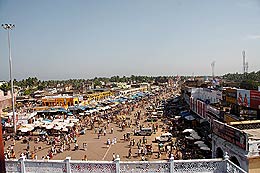 |
During Anga-Raga (Nava-Yauvana) ceremony Lord
Jagannatha's Deities are newly painted. But the real reason for
His absence in the temple is actually enjoying undisturbed privacy
and svakiya-rasa with His wife Laksmi. Then Lord Jagannatha asks
Her permission to leave and comes out for His Ratha-yatra chariot
festival.
|
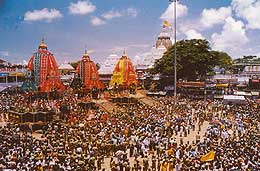 |
Deities of Lord Jagannatha, Baladeva, and Lady Subhadra are by
rolling movements with sounds of drums carried out of the temple
to Their carts. It is grand festival and the biggest event in
whole Orissa. Only during the Ratha-yatra festival the
big Deities can be seen by all including non-hindus. The king
of Orissa then sweeps the street in front of the carts with a
golden handled broom.
|
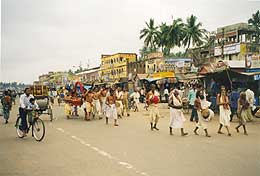 |
Sri Caitanya experienced Ratha-yatra festival in unique
way. In the mood of Srimati Radharani He remembered a time when
inhabitants of Vrindavan came to meet Krishna at Kuruksetra. Gopis
were cowherds and Krishna was King with weapons and chariots and
all over were splendid riches. Gopis remembered Krishna as a simple
cowherd boy in Vrindavan and paradoxically felt even more separation
than before...
|
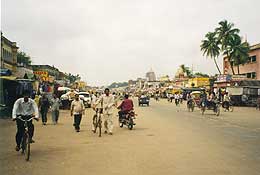 |
...Therefore they took the rein (ropes) of His chariot and with
all strength start to pull Him back to Vrindavan. This is the
real mood of Ratha-yatra relished by gaudiya-vaisnava devotees.
Sri Caitanya tasted many ecstatic emotions during the festival
and afterwards the verse written by Rupa Gosvami pleased Him very
much: "I am the same Radharani, and now we are meeting together.
It is very pleasant, but I would still like to go to the bank...
|
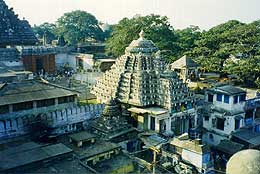 |
... of the Yamuna beneath the trees of the forest there. I wish
to hear the vibration of His sweet flute playing the fifth note
within that forest of Vrindavan." Ratha-yatra was also one
of the favorite festivals of Srila Prabhupada. He used to say
that he never attended festival in Puri, but he always had his
own. And that was true in his childhood when he celebrated it
with his neighbors, as well as in later times when he introduced
it in many western towns.
|
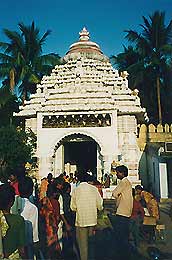 |
Gundica Mandir (Temple)
This temple is located at the opposite end of main road about
3 km northeast of the Jagannatha Temple. The temple at Gundica
is called Sundaracala and Jagannatha Temple is called Nilacala.
At the time of the Ratha-yatra festival. Lord Jagannatha goes
to the Gundica Temple and stays there for one week. After one
week He returns to His original temple. It is said that the wife
of lndradyumna, the king who originally established the temple
of Jagannatha, was known as Gundica. The cleansing of the Gundica
Temple - Gundica-marjana - takes place the day before the
Ratha-yatra festival as mentioned in Caitanya-caritamrita.
|
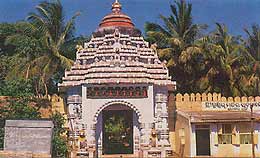 |
"...The
next day Lord Caitanya smeared sandalwood pulp on His personal
associates, gave each a broom and went to Gundica. They cleansed
everything nicely including the ceiling. They moved Lord Jagannatha's
throne to clean underneath it. Sri Caitanya cleansed in jubilation
and chanted Hare Krishna simultaneously, everyone followed His example... |
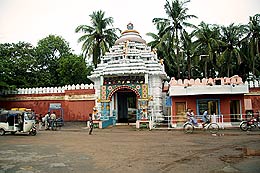 |
...Lord Caitanya's
entire body was covered with dust and dirt as He washed the temple
with His tears. Imitating Lord Caitanya, the devotees gathered
dust and straw in their cloths and discarded it outside into one
pile. Lord Caitanya's own pile of straw and dust was much bigger
than the devotee's collective pile. Lord Caitanya mopped and polished
the room and throne with His cloth. All the rooms were cleansed
with a hundred water pots... |
 |
...Whenever
anyone had to speak, they uttered only the holy name of Krishna.
Lord Caitanya approached everyone just to teach them how to work.
While praising the good and chastising the bad, without bearing
grudge, Lord Caitanya said, "You have done well, teach others."
Lord Caitanya personally instructed how to receive the Supreme
Lord within one's cleansed and pacified heart." |
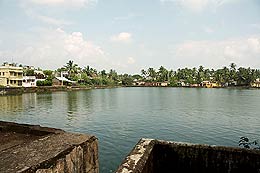 |
Indradyumna Sarovara
This water tank is about a half km from the Gundica Temple.
|
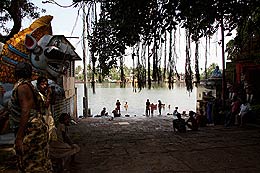 |
Water to clean the Gundica Temple is brought from this kunda.
|
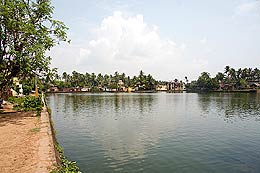 |
Sri Caitanya engaged in water sports with His intimate associates
in this tank. Sri Caitanya once manifested His Mahavishnu form
showing His associates His supernatural qualities as an incarnation
of God.
|
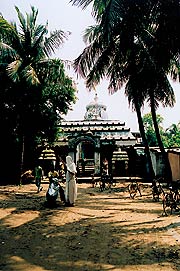 |
On the way from Gundica temple to the Indradyumna tank there
is a temple known as the Yagna Narasimha.
|
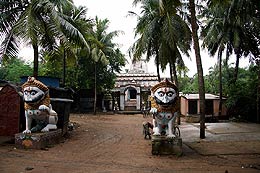 |
As depicted in the purana once King Indradyumna stayed near Nilakantheswar
temple to make arrangements to perform Aswamedha Yagna (Horse
sacrifice) for one thousand years...
|
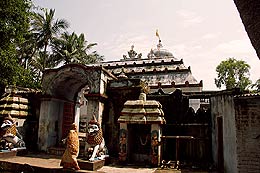 |
...On the advice of Sage Narada, King Indradyumna made a Narasimha
Deity out of black stone and placed it under black sandal wood
tree and worshipped Him. It is believed that in front of this
temple the Aswamedha Yagna took place and hence He known as 'Yagna
Narasimha'.
|
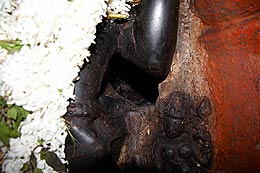 |
There are two Deities of Lord Narasimha inside the temple, one
behind the other. The Deity in front is called Santa Narasimha.
In local language 'Santa' means 'Calm' or 'Sober'. Anyone who
sees this image of Lord Narasimha will have his anger, frustration,
and anxiety will vanish. The Deity in the back is called Ugra
Narasimha. In local language 'Ugra' means 'Angry'. He is the internal
mood of Narasimha.
|
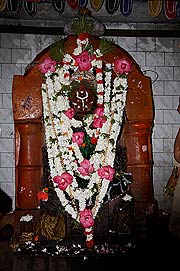 |
It is said, that when Kalapahad attacked Puri and was smashing
Deities of various temples, he saw Santa Narasimha and his anger
subsided; hence he could not break the Deity as he had planned.
|
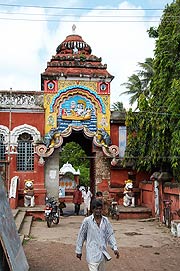 |
Jagannatha Vallabha Gardens
Sri Caitanya used to meet here with Ramananda Raya. Ramananda
Raya used to train girls here to dance for the pleasure of Lord
Jagannatha.
|
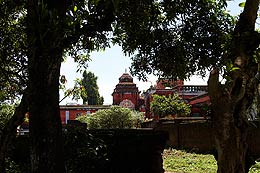 |
There are three altars in the Jagannatha Vallabha temple. On
one altar there are large Deities of Jagannatha, Baladeva and
Subhadra. On the middle altar there are Deities of Lord Caitanya
(in saffron) and Ramananda Raya (in white). Radha-Krishna Deities
are on the third altar. Caitanya Mahaprabhu performed many pastimes
here like Deliverance of King Prataprudra.
|
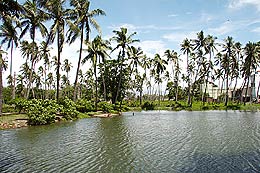 |
During Ratha
yatra Sri Caitanya takes rest hear for nine days while Jagannatha
stays in the Gundicha Temple. |
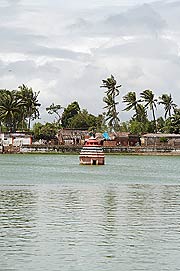 |
A little ways away from the garden is Narendra Sarovara.
This is a large tank where the boat festival called Chandana-yatra
is held during which Lord Jagannath goes for a boat ride. Since
Lord Jagannath is very heavy, the vijaya vigraha (festival Deity),
known as Govinda, rides in the boat. Sri Caitanya and his devotees
took part in this festival.
|
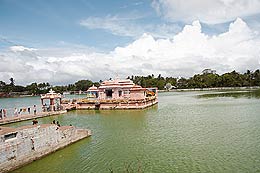 |
There is a small temple on an island about 30m (100 ft) into
the tank, with Deities of Jagannath, Baladeva, and Subhadra.
|
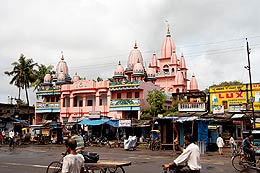 |
Bhaktisiddhanta Saraswati
Thakura's Birthplace
Great vaisnava saint, Bhaktivinod Thakur, lived in Jagannatha
Puri. As the regional governor he was also in charge of Jagannatha
Temple.
|
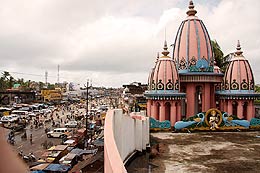 |
He was not only saint, but he could see more clearly motivation
of people, which made him a very effective judge. British colonizers
used to look at the managerial qualities of Indians with contempt,
but Bhaktivinod won their recognition also in this regard. In
few minutes he could finish the cases which others were unable
to close in hours.
|
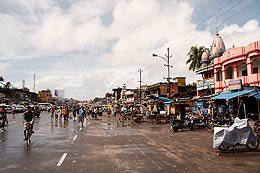 |
In his house a son Bhimal Prasad was born, who later became famous
all over India as Bhaktisiddhanta Sarasvati. When Bhimal Prasad
was a child,
Ratha-yatra cart stopped in front of Bhaktivinod's house and like
in times of Lord Caitanya couldn't move for a while...
|
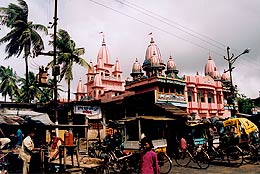 |
... Bhaktivinoda was a governor and his wife could come out with
Bhimal Prasad in her arms and place him directly in front of the
Jagannath's Deities...
|
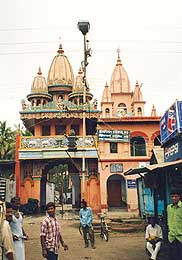 |
...A flower garland fell on the child, thus blessing Bhimal Prasad.
Shortly afterwards the cart could move again and Ratha-yatra continued.
|
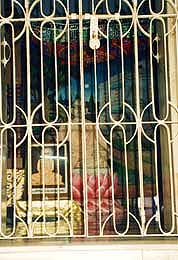 |
The temple at his birthplace is located about 1 km from the Jagannatha
Temple on Grand Road. There is a Gaudiya Math temple here, with
Jagannatha Deities and a murti of Bhaktisiddhanta Maharaja. There
are also murtis of the heads of the four Vaishnava sampradayas
— Vishnuswami, Madhvacarya, Nimbarka, and Ramanuja.
|
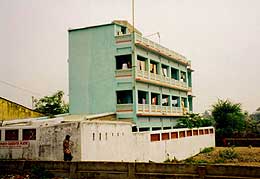 |
Gopinath Gaudiya Math. |
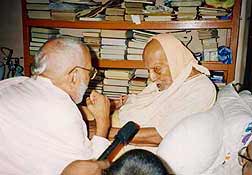 |
Puri Maharaja (right) is a disciple of Bhaktisiddhanta Sarasvati.
|
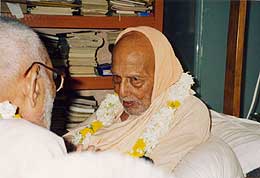 |
Here he is engaged in talk with Narayana Maharaja (on the left).
|
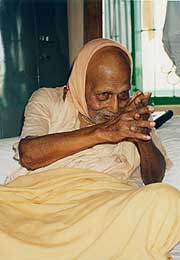 |
One can only guess what
they are talking about... |
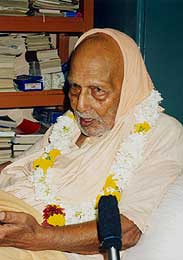 |
|
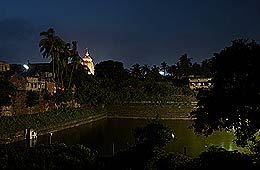 |
Sveta-Ganga
|
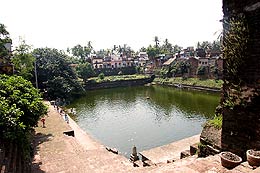 |
It is said in Sastra that if one take bath in Sveta Ganga and
takes darshan of Sveta Madhava (These name is given to King Sveta
by Lord, he was great devotee of Lord Jagannatha) and Matsya Madhava,
he will free from all sins, in particular the offence of inadvertently
stepping over Jagannatha Prasadam.
|
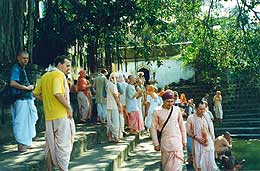 |
The taking bath in Sveta Ganga is same as taking bath in Ganga
River, because many incident proves that the Sveta Ganga is non
different from the Ganga River in Kashi.
|
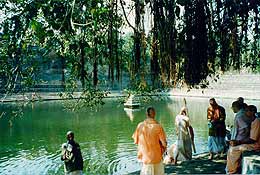 |
...and if one is not to take complete bath, it is possible to
take at least tree drops of its water on ones head.
|
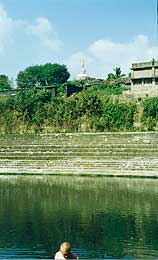 |
In Puranas it is described
as Akrishna, meaning “not black.” |
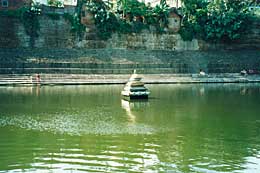 |
Sveta means white. People here say that once a year, for a brief
moment, the water of this pond turns as white as milk.
|
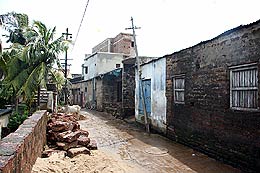 |
This pond is located just opposite to the house of Sarvabhauma
Bhattacarya.
|
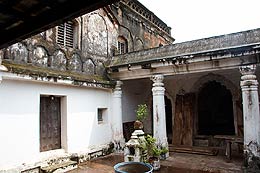 |
Sarvabhauma Bhattacarya's House
This house is about 1,5 km south of the Simha-dwara of the
Jagannatha Temple. If you walk out of the Jagannatha Temple, turn
right and follow the road toward Swarga-dwara (the ocean).
|
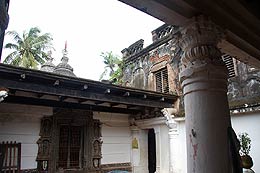 |
Go past the first right, which goes around the temple, and then
walk about another 100 m and make the next right to Sweta Ganga
Tank. Sarvabhauma's house, better known as Gangamata Math, is
on the left.
|
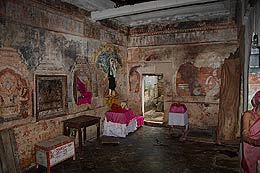 |
When Lord Caitanya first came to Puri, He fainted in front of
Deity of Lord Jagannatha and Sarvabhauma took Him to his home.
|
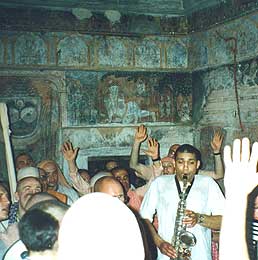 |
He wanted to teach Him Vedanta in order to protect Him from allurements
of material world. At the end he recognized who He actually is
and became His devotee.
|
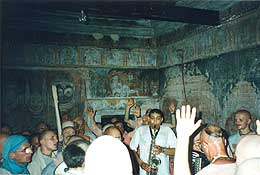 |
Indradyumna Swami leads the ecstatic kirtan in the very same
room where Sarvabhauma discussed Vedanta.
|
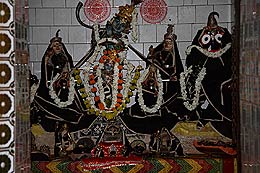 |
There are Radha-Krishna Deities called Radha-Rasikaraja in this
house, which are said to have been worshiped by Sarvabhauma Bhattacarya.
The black wooden sandals are said to have belonged to Sarvabhauma.
|
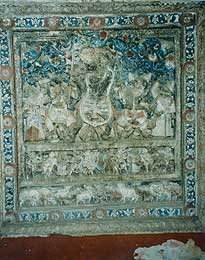 |
Inside there are paintings
of devotional scenes all over the walls. |
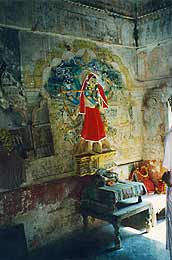 |
Here Lord Caitanya manifested His Sad-bhuj form with six arms,
which shows that all His forms as Ramachandra (holding bow and
arrow), Krishna (with the flute) and Caitanya (holding waterpot
and rod of a sannyasi) are different manifestations of His Supreme
Personality, thus exhibiting simultaneous oneness and difference.
|
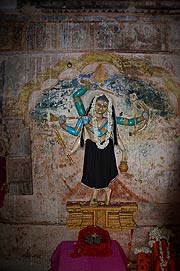 |
Sad-bhuj
|
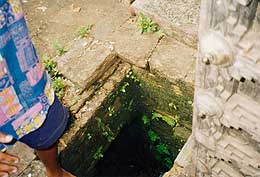 |
There is a hidden tunnel
in the house that is said to lead in two directions — to the sea
and to the Jagannatha Temple. It is said that this tunnel was used
by Sri Caitanya |
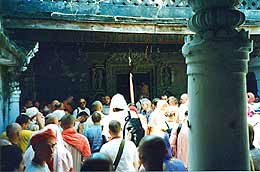 |
During His first visit, Lord Caitanya stayed here for 5 days.
Than He departed for His South India tour.
|
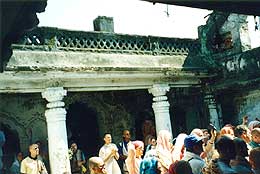 |
After the Ratha-yatra festival Lord Caitanya was offered a very
wonderful feast here in Sarvabhauma Bhattacarya's house. The elaborate
descriptions of all preparations can be found in Caitanya-caritamrita.
It seemed that Sri Caitanya could match the amount of prasadam
taken by Jagannatha Himself (!)
|
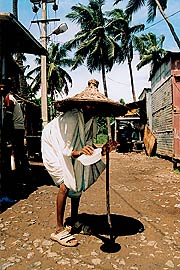 |
|
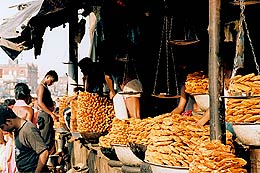 |
Lord Jaggannath's favourite sweets are often seen at the bazars.
|
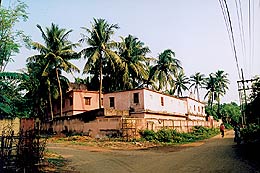 |
Chatak Parbat Gaudiya Math
This temple is near a large white water tower, about a ten-minute
walk from Haridasa Thakura’s samadhi, close to the Tota Gopinath
Temple.
|
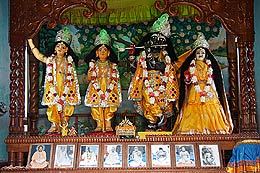 |
This temple is in the area where Sri Caitanya mistook the sand
dune hills to be Govardhan Hill.
|
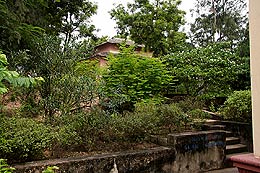 |
"Identical with Giriraj govardhan" says on the wall...
|
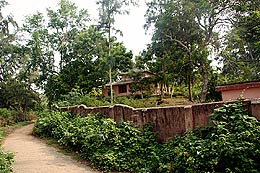 |
The bhajan-kutir of Srila Bhaktisiddhanta Maharaja is
here, as well as his bed.
|
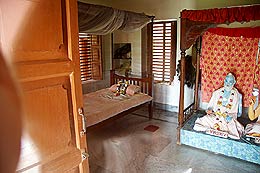 |
There is a murti of Veda-Vyasa in the bhajan-kutir.
|
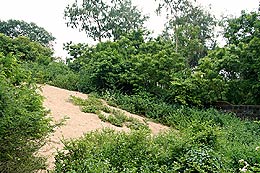 |
Sand dune that had witnessed mahabhava...
|
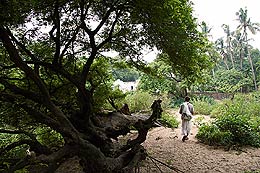 |
...is in the proximity to the entrance of the...
|
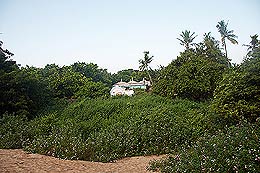 |
Tota Gopinath Mandir
|
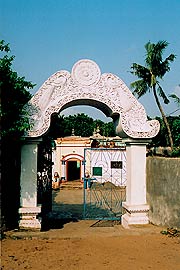 |
This temple is the home of one of the most amazing Deities of
the Supreme Lord.
|
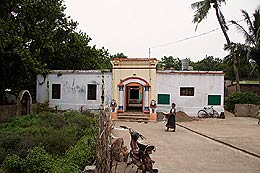 |
The sign on the door says "Shree Tota Gopinathjee,"
and there are two stone lions by the door.
|
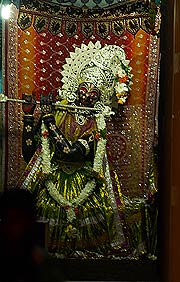 |
On the middle altar is Tota Gopinath, accompanied by black deities
of Radha and Lalita. Tota Gopinath is in a sitting position. Sri
Gadadhar used to worship Tota Gopinath regularly. When he was
old and could not reach with the garland to his neck, Tota Gopinath
sat down so that Gadadhar could give Him the garlands.
|
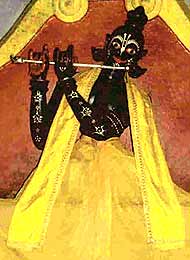 |
Gaudiya Vaishnavas accept that Sri Caitanya Mahaprabhu ended
his manifested pastimes in Puri by entering into the knee of the
Tota Gopinath Deity. If you come in the morning around seven,
you can give a donation to see the crack in His knee where Lord
Caitanya entered the Deity and left this world.
|
 |
On the far left altar are Lord Balarama and his two wives, Revati
and Varuni.
|
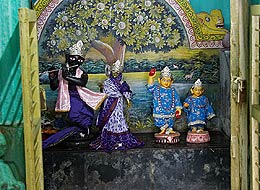 |
On the right altar are the Deities of Radha-Madana Mohan and
Gaura Gadadhar.
|
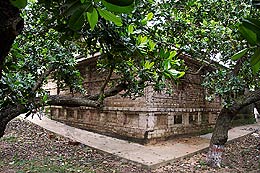 |
"Tota" means "garden".... |
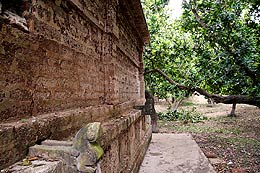 |
...and this temple is situated amidst of nice greenery...
|
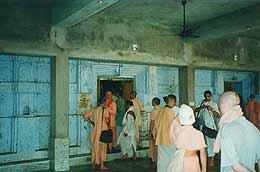 |
It is a favorite place for quiet bhajan for many devotees...
|
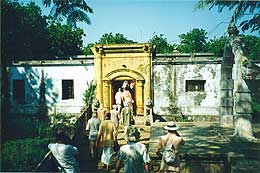 |
...especially in early morning and evening time.
|
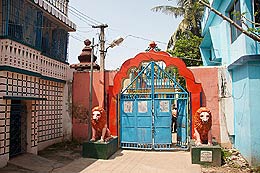 |
Siddha Bakula is the bhajan-kutir of Haridasa Thakura,
where he chanted 300,000 names of God daily.
|
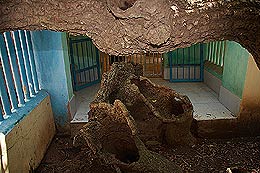 |
Since Haridas could not enter the Jagannatha Temple, being of
a Muslim family, Lord Caitanya took the stick He had used as His
toothbrush and stuck it in the ground.
|
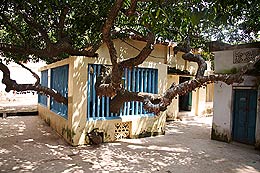 |
...It immediately grew into a beautiful shade tree, under which
Haridas Thakur lived...
|
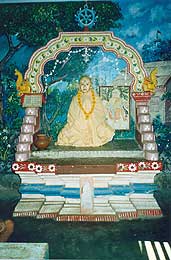 |
The devotees came to Haridas Thakur saying, that Lord Caitanya
wanted to meet him. He replied, "If I could just get a solitary
place near the temple, I could stay there and pass my time. I
do not wish the servants of Lord Jagannatha to touch me. I would
remain there in the garden alone. That is my desire..."
|
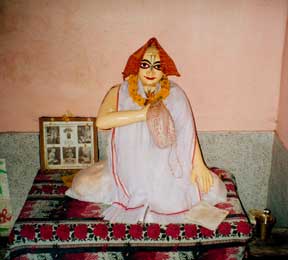 |
...Happy to
hear this, Sri Caitanya came personally to meet Haridas after His
devotees departed for sea bathing and their residential accommodations... |
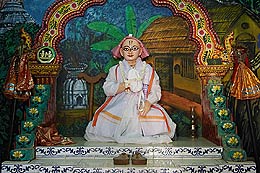 |
Sri Caitanya took Haridas within the flower garden and there,
in a very secluded place, He showed him his residence. Sri Caitanya
requested him, "Remain here and chant the Hare Krishna maha-mantra.
I shall personally come here to meet you daily...
|
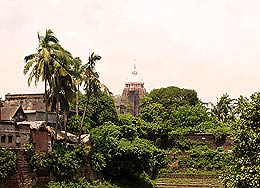 |
...Remain here peacefully, and look at the cakra on top of Lord
Jagannatha's temple and offer obeisances...
|
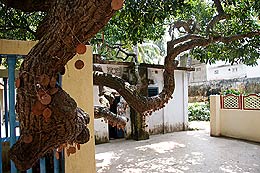 |
... As far as your prasadam, I shall arrange to have that sent
here."
|
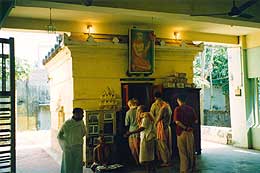 |
Rupa Goswami recited Lalita
Madhava and Vidagdha Madhava before Sri Caitanya and His followers
under the tree here. During his stay in Puri, Sanatana Goswami lived
here with Haridasa Thakura. |
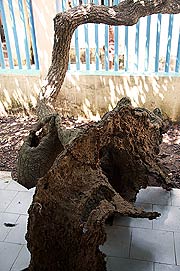 |
In course of time, the King of Orissa ordered his officers to
cut down the tree here in order to construct Lord Jagannatha's
Ratha-yatra cart. Big amount of wood is needed, since the carts
are about 13 m high and each year new ones are constructed...
|
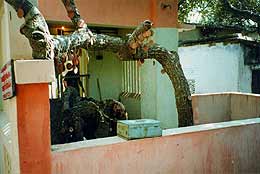 |
...The next morning the
royal officers found the tree hollow and returned without cutting
it. The main branch of the tree is petrified, stone to the touch.
This is the part that was transformed, so the king would not take
it. People tie stones to this kalpa-taru (wish-fulfilling tree)
and make their wishes. |
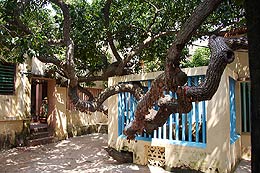 |
Haridas attained such an elevated position of ecstasy from chanting
the Hare Krishna mantra that even though a beautiful prostitute
came to tempt him with sex, he was not interested. Thus, he is
called the namacarya: the master of chanting the holy names.
|
 |
In 1991, a small shrine was found here, along with the old and
bent tree under which Haridas would chant. However, since then,
as found in 2001, there is a nice temple and plenty of walled
protection for the tree at this place.
|
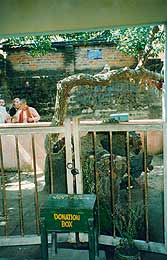 |
This is considered
a very holy spot for the Gaudiya Vaisnavas, as this is where Haridasa
Thakura left his body and where, after his departure, Sri Caitanya
carried his body while dancing in ecstasy. |
 |
Gambhira is located close to Siddha Bakula. There is a
sign over the door reading "Shri Shri Radhakanta Math, Gambhira".
|
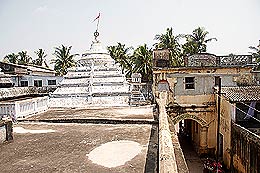 |
It is about half a km from the Lion Gate going toward Swarga-dwara
or the ocean.
|
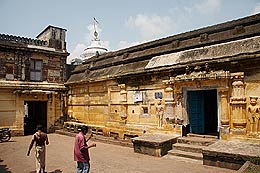 |
This is the former house of Kasi Misra.
|
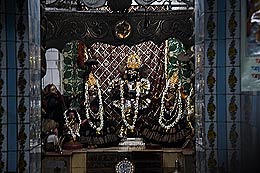 |
Radhakanta was worshiped by Gopalaguru Goswami, the disciple
of Vakreswara Pandit. On the far right is a deity of Sri Caitanya,
and on the far left is Nityananda.
|
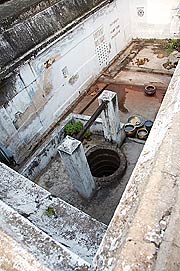 |
The well where Sri Caitanya drunk...
|
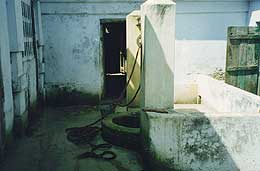 |
|
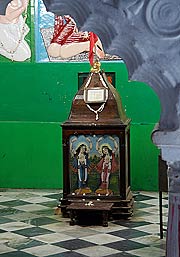 |
You can look through a small barred window into the room called
Sri Gambhira. This is the room where Sri Caitanya lived.
|
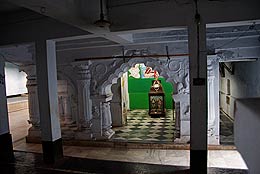 |
There is a lamp here that remains always lit and never goes out.
You can see Sri Caitanya's original wooden sandals. His quilt,
water pot, and bed.
|
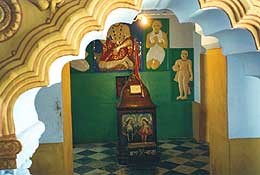 |
Sri Caitanya lived for 12 years in this room. On a marble throne,
a murti of Sri Caitanya is encircled by a cloth, so that just
His face is visible.
|
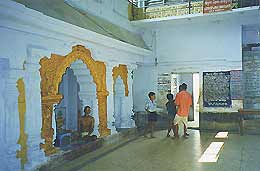 |
...Lord Caitanya's ecstatic symptoms manifested in Gambhira
are incomprehensible by common man, but Gaudiya Vaishnavas accept
them as the topmost manifestations of love of God...
|
 |
...It is described that there in the Gambhira, Mahaprabhu experienced
Radhika's separation for Krishna when He went to Mathura and Dwaraka,
and She remained in Vrindavana...
|
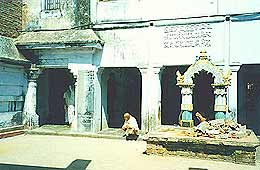 |
...His devotees used to sleep in front of Caitanya's room so
that He would not hurt Himself while experiencing intense feelings
of separation...
|
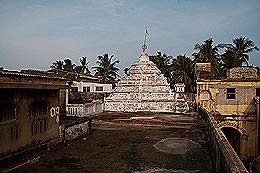 |
...Caitanya-caritamrta describes...
|
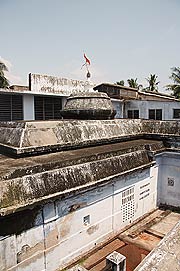 |
...that sometimes Lord Caitanya went away in spite of all the
protective efforts of devotees...
|
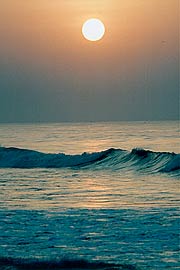 |
...and they have searched for him...
|
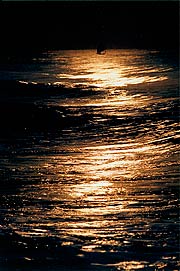 |
...all night...
|
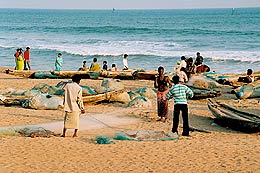 |
...and found Him in the fisherman's nets..
|
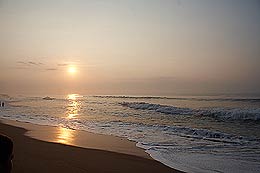 |
Sunrise in Jagannath Puri...
|
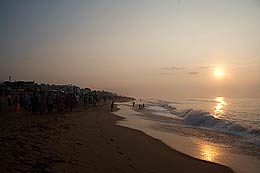 |
...is simply "oceanic"...
|
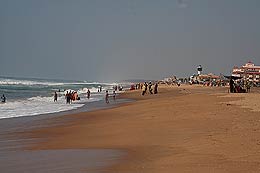 |
...and many take that...
|
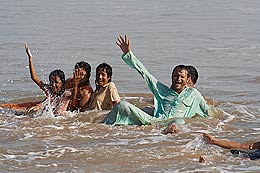 |
...just for recreation.
|
 |
But the ocean current can be strong in Puri, and drownings are
not unheard of. Be careful when swimming.
|
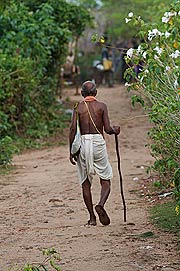 |
Local people know that.
|
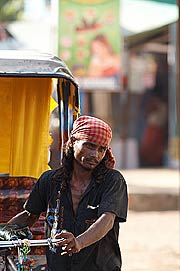 |
...and take the safe road.
|
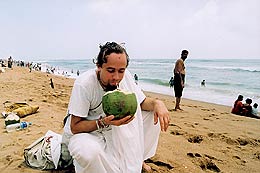 |
Green coconuts provide very pleasant beverage called "dab".
It is very refreshing drink very much welcomed in hot Indian climate.
|
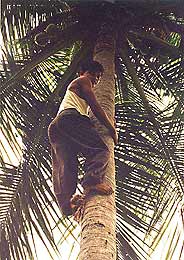 |
To find good source of drinking water can be troublesome and
dab is so pure that during wartime in emergency cases it was used
as blood infusion in absence of specially manufactured substances.
|
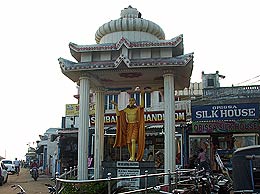 |
On the way from Gambhira to Swarga-dwara area where this quite
unique statue of Lord Caitanya at the road crossing...
|
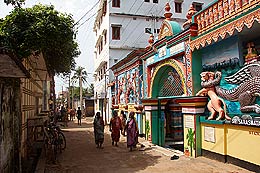 |
...there is this colorful Gaudiya Math...
|
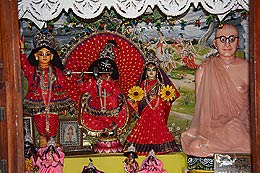 |
We know that Bhaktisiddhanta Sarasvati liked dioramas and exhibitions
of that kind...
|
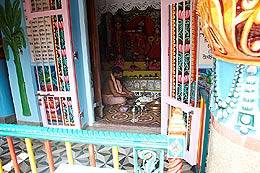 |
...and this temple is so colorfully decorated...
|
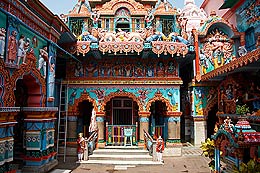 |
...with wonderfull murals...
|
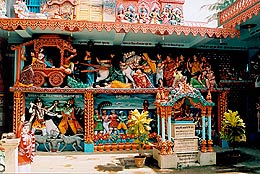 |
...that almost every main lila...
|
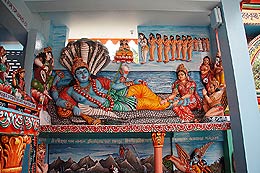 |
...from the Bhagavatam...
|
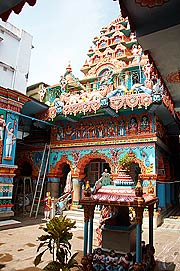 |
...can be found...
|
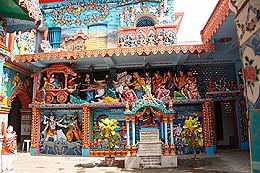 |
...in some corner...
|
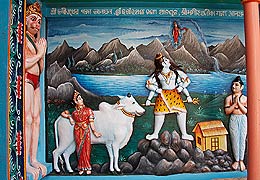 |
...or on the wall...
|
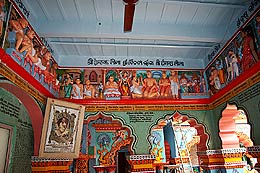 |
...of this eye capturing display.
|
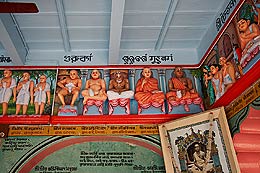 |
Parampara...
|
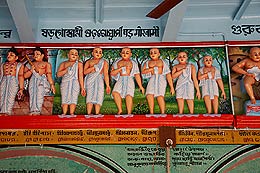 |
...Goswamis...
|
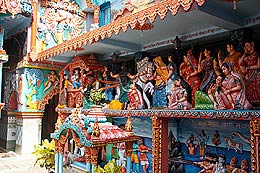 |
...Ratha-yatra mood...
|
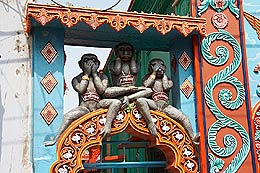 |
...simply everything!
|
 |
Jagadananda Math, where Jagadananda broke the pot of sandalwood
oil...
|
 |
...is the Radha Syamasundara Deities of Brahmananda Bharati.
|
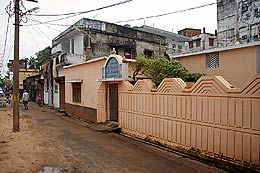 |
Across the road is Radha Giridhari Temple...
|
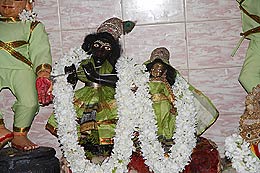 |
...with beautiful Deities...
|
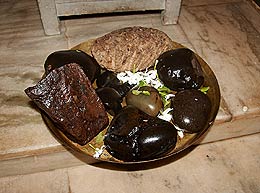 |
...and interesting salagram-silas...
|
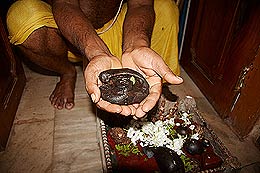 |
...of really amazing shapes.
|
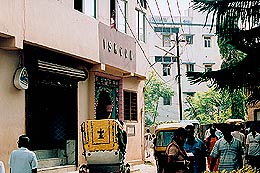 |
ISKCON temple...
|
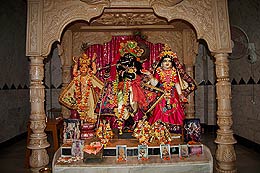 |
...with the Radha Krisna Deities is at the spot....
|
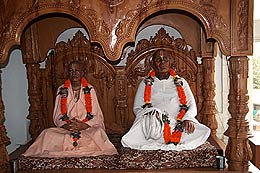 |
...where Bhaktivinoda Thakura had his bhajan kutir...
|
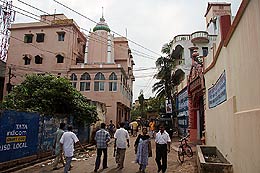 |
...next to samadhi of Haridas Thakur.
|
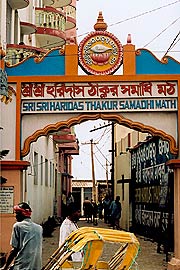 |
The samadhi temple of Haridasa Thakura, the nama-acarya
(teacher of the chanting the holy names) is located by the beach
in the Swarga-dwara area near the Purusottama Gaudiya Math. If
you are walking on the beach there is a sign for the Sea Hawk
Hotel. It is right behind this hotel. Many rickshaw-walas know
where it is located.
|
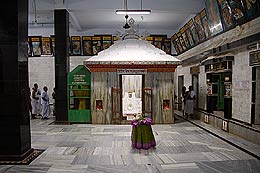 |
Within the temple, the chapel structure is Haridasa Thakur’s
samadhi....
|
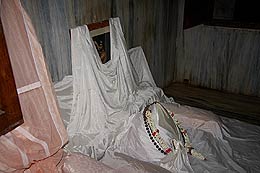 |
There is a nice painting of Haridasa Thakur in the samadhi.
|
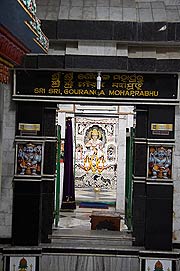 |
On the center altar is a wooden Deity of Sri Caitanya; on the
right, Prabhu Nitya-nanda; and on the left, Advaita Acharya.
|
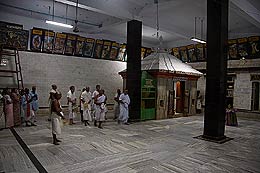 |
It is interesting to see how during evening arati...
|
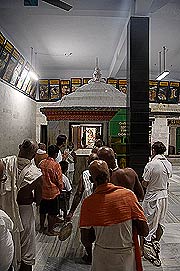 |
...devotees get the darsan of the Deities through the Haridasa's
samadhi...
|
 |
...and then they go to the next altar for darsan.
|
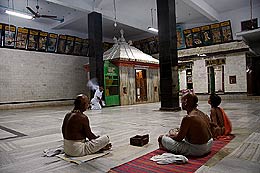 |
...but the kirtan of the holy names continues almost constantly.
|
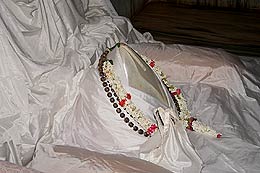 |
Disappearance of Haridas Thakur.
Like a great mystic yogi or Bhisma, Haridas gave up his material
body in the presence of Lord Caitanya and all the devotees at
Siddha-bakula...
|
 |
...Then Sri Caitanya picked up Haridas Thakur's body and chanted
and danced in ecstasy for sometime with the other devotees. Then
Haridas was carried to the sea beach for His burial ceremony,
which was personally conducted by Lord Caitanya.
|
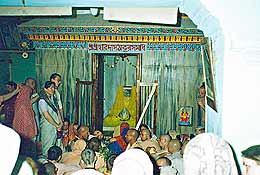 |
Sri Caitanya gave a benediction
saying, "Anyone who has chanted and danced here at Haridasa
Thakura's samadhi will achieve the favor of Krishna very soon... |
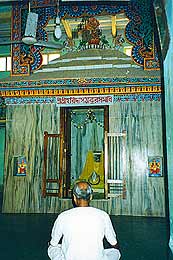 |
...There is such wonderful power in seeing Haridasa Thakura."
|
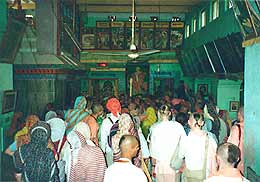 |
...That is also why devotees
use to came here and chant the holy names of God. |
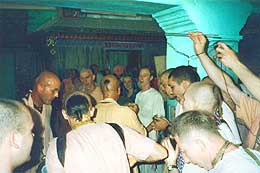 |
Indradyumna Swami leads
the kirtan... |
 |
...and... |
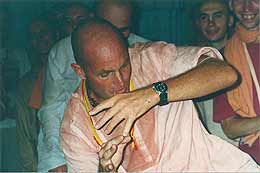 |
...everyone who has seen his kirtans says that it is really worth
to be there...
|
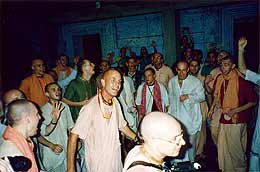 |
...after short intermission...
|
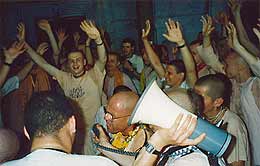 |
...different
kirtan leaders take up the lead for some time... |
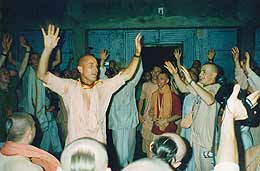 |
...and everything
leads to ecstatic conclusion. |
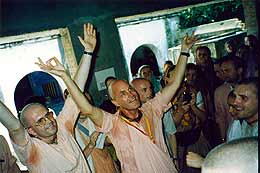 |
Jagannatha, Baladeva, Subhadra Kee Jay! Sri Caitanya Mahaprabhu
Kee Jay! Gaura Premande!
|
















































































































































































